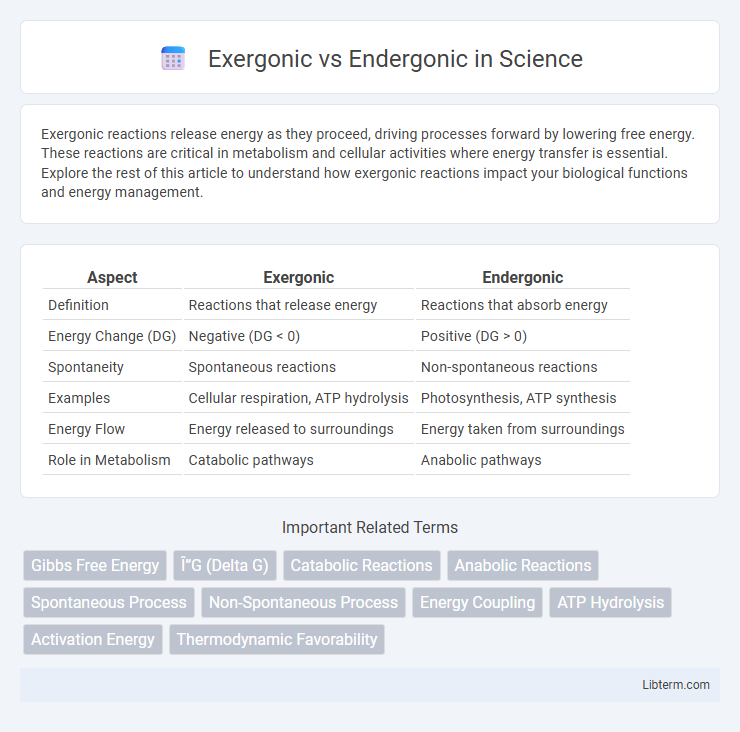Exergonic reactions release energy as they proceed, driving processes forward by lowering free energy. These reactions are critical in metabolism and cellular activities where energy transfer is essential. Explore the rest of this article to understand how exergonic reactions impact your biological functions and energy management.
Table of Comparison
| Aspect | Exergonic | Endergonic |
|---|---|---|
| Definition | Reactions that release energy | Reactions that absorb energy |
| Energy Change (DG) | Negative (DG < 0) | Positive (DG > 0) |
| Spontaneity | Spontaneous reactions | Non-spontaneous reactions |
| Examples | Cellular respiration, ATP hydrolysis | Photosynthesis, ATP synthesis |
| Energy Flow | Energy released to surroundings | Energy taken from surroundings |
| Role in Metabolism | Catabolic pathways | Anabolic pathways |
Introduction to Exergonic and Endergonic Reactions
Exergonic reactions release energy by breaking down complex molecules into simpler ones, resulting in a negative Gibbs free energy change (DG < 0), which indicates spontaneous processes such as cellular respiration. Endergonic reactions require an input of energy to synthesize complex molecules from simpler ones, characterized by a positive Gibbs free energy change (DG > 0), exemplified by photosynthesis. Understanding the energy dynamics of exergonic and endergonic reactions is essential for studying metabolic pathways and biochemical energy transfer.
Defining Exergonic Reactions
Exergonic reactions are chemical processes that release energy, typically in the form of heat or light, as reactants transform into products, resulting in a negative Gibbs free energy change (DG < 0). These reactions occur spontaneously and are essential for driving biological activities such as cellular respiration and ATP hydrolysis. Key examples include combustion reactions and the oxidation of glucose, where energy release supports various metabolic functions.
Defining Endergonic Reactions
Endergonic reactions are chemical processes that require an input of energy to proceed, characterized by a positive Gibbs free energy change (DG > 0). These reactions absorb energy from their surroundings, often in the form of ATP hydrolysis or light, to drive non-spontaneous transformations such as photosynthesis or active transport across membranes. Unlike exergonic reactions, which release energy, endergonic processes are essential for synthesizing complex molecules and maintaining cellular functions.
Key Differences Between Exergonic and Endergonic Reactions
Exergonic reactions release energy by breaking down complex molecules, resulting in a negative Gibbs free energy change (DG < 0), while endergonic reactions consume energy to form complex molecules, characterized by a positive Gibbs free energy change (DG > 0). Exergonic processes are spontaneous and drive metabolic activities such as cellular respiration, whereas endergonic reactions require energy input, often coupled with ATP hydrolysis, as seen in photosynthesis. The fundamental distinction lies in energy transfer direction: exergonic releases stored energy, endergonic stores energy by building molecular structures.
Role of Gibbs Free Energy in Reaction Types
Exergonic reactions release energy as Gibbs free energy decreases (DG < 0), driving spontaneous processes that occur without external input. Endergonic reactions require energy input, displaying an increase in Gibbs free energy (DG > 0) and non-spontaneity, meaning they depend on coupling with exergonic reactions or energy sources like ATP hydrolysis. Gibbs free energy serves as the critical determinant for spontaneity and energy transfer in biochemical and chemical reaction pathways.
Biological Importance of Exergonic Processes
Exergonic processes release energy by breaking down molecules, playing a crucial role in cellular metabolism and driving biological reactions essential for life. These reactions power vital functions such as ATP synthesis, muscle contraction, and active transport across membranes. The energy released in exergonic reactions couples with endergonic reactions, enabling organisms to maintain homeostasis and perform growth, repair, and reproduction.
Biological Significance of Endergonic Processes
Endergonic processes play a crucial role in biological systems by enabling energy-dependent reactions necessary for cellular functions such as photosynthesis, active transport, and biosynthesis of macromolecules. These reactions require an input of energy, typically derived from ATP hydrolysis or electron transport chains, to drive the formation of complex molecules from simpler precursors. The ability of cells to couple endergonic and exergonic reactions maintains metabolic balance and supports growth, reproduction, and homeostasis.
Real-World Examples of Exergonic Reactions
Exergonic reactions release energy, driving crucial biological processes such as cellular respiration, where glucose is oxidized to produce ATP. Combustion of fossil fuels like gasoline powers engines by releasing stored chemical energy in an exergonic manner. Photosynthesis, although an endergonic process overall, involves exergonic steps like the light reactions that release energy used to fuel the synthesis of organic molecules.
Real-World Examples of Endergonic Reactions
Photosynthesis serves as a prime example of an endergonic reaction where plants absorb sunlight to convert carbon dioxide and water into glucose, storing energy in chemical bonds. Protein synthesis is another endergonic process requiring ATP to build complex polypeptides from amino acids, essential for cellular function. Charging a battery involves endergonic reactions as electrical energy is stored as chemical energy within the battery's electrodes.
Exergonic and Endergonic Reactions in Cellular Metabolism
Exergonic reactions in cellular metabolism release energy by breaking down complex molecules like glucose during cellular respiration, driving ATP synthesis essential for cell functions. Endergonic reactions require energy input to form complex molecules from simpler ones, such as the synthesis of proteins and nucleic acids in anabolic pathways. The coupling of exergonic and endergonic reactions ensures efficient energy transfer and maintenance of metabolic balance within cells.
Exergonic Infographic

 libterm.com
libterm.com